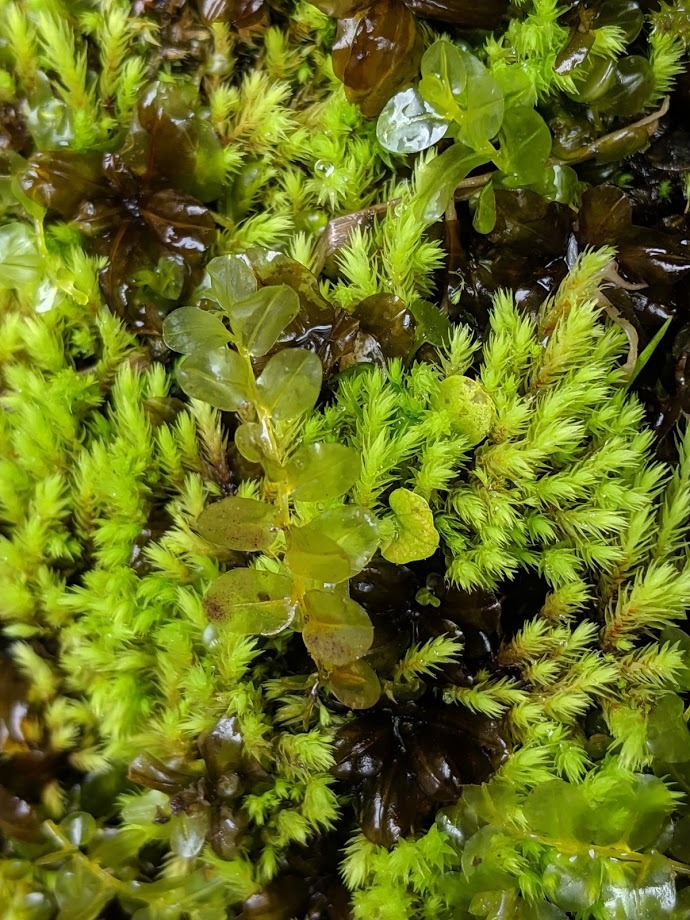Orthomnion novae-zealandiae
(Colenso) T.J.Kop. & Y.SunSynoicous. Mats or loose tufts on rocks. Sterile stems stoloniferous, prostrate, 2–8 cm long, pale brown to green, covered with red-brown rhizoids ventrally. Fertile stems erect, to c. 30 mm long, pale brown to green. Leaves on stoloniferous stems complanate, ±distichous, strongly contorted when dry, mostly elliptic, c. 3–4 mm long, 2–4 mm wide, undulate; costae percurrent; margins entire to weakly toothed, undulate, with 3–4 rows of more elongate cells forming a border; cells c. 30 μm long, 15–30 μm wide. Leaves on erect stems spreading, strongly contorted when dry, elliptic to obovate, 5–7 mm long, 3–5 mm wide, undulate; apex rounded to mucronate, usually short-apiculate; costa subpercurrent; margins with single short blunt teeth in apical half or nearly entire, undulate, with 3–4 rows of more elongate cells forming a border; laminal cells rounded-hexagonal, 30–60 μm long, 21–35 μm wide, larger and more elongate near costa and base. Setae 20–40 mm long, yellow- or pale red-brown, smooth. Capsules inclined to pendulous, broadly ovoid or obovoid, 3–4 mm long. Opercula curved-rostrate from conic base, c. 1.5–2 mm long.
MonT, VAlp. Also in Qld and N.S.W. New Zealand. Along the Great Dividing Range east of Lake Eildon, beside fast-flowing streams in cool, wet and shady sites and often in gorges near waterfalls or underneath rock ledges.
Orthomnion novae-zealandiae is very similar to the Northern Hemisphere O. rostratum, from which it differs only by the larger lamina cells and decurrent leaf bases (Harris 2008, as Plagiomnium; Wyatt & Ramsay 2012, as Plagiomnium). These characters vary in both species, which has led Harris (2008) to suggest that O. novae-zealandiae might be better included in O. rostratum. Orthomnion novae-zealandiae is retained here on the basis that there is a more substantial genetic difference between Australasian and Norther Hemisphere populations than among Northern Hemisphere populations. There may also be a difference in chromosome numbers between the two species with O. novae-zealandiae having n = 14 (Ramsay 2011, as Plagiomnium), while in O. rostratum n = 12 (Koponen 1972, as Plagiomnium). Haploid chromosome counts of n = 7 and n = 6 have also been reported in Plagiomnium (Fritsch 1991), indicating a polyploid origin for the Australasian O. novae-zelandiae (Wyatt & Ramsay 2012). Synoicous species, like O. novae-zealandiae, have also been shown to be allopolyploid in allozyme studies (e.g. Wyatt et al. 1992, 1993; Wyatt & Odrzykoski 1998).
 Spinning
SpinningMisapplications
Fritsch, R. (1991). Index to bryophyte chromosome counts. Bryophytorum Bibliotheca 40: 1–352.
Harris, E.S.J. (2008). Paraphyly and multiple causes of phylogenetic incongruence in the moss genus Plagiomnium (Mniaceae). Taxon 57: 417–433.
Koponen, T. (1972). The East Asiatic species of Plagiomnium sect. Rostrata (Bryophyta). Acta Botanica Fennica 97: 1–29.
Ramsay, H.P. (2011). Australian mosses-new chromosome numbers and a compilation of chromosome data. Telopea 13: 577–619.
Wyatt, R.; Odrzykoski, I.J. (1998). On the origins of the allopolyploid moss Plagiomnium cuspidatum. The Bryologist 101: 263–271.
Wyatt, R.; Odrzykoski, I.J.; Stoneburner, A. (1992). Isozyme evidence of reticulate evolution in mosses: Plagiomnium medium is an allopolyploid of P. ellipticum × P. insigne. Systematic Botany 17: 532–550.
Wyatt, R.; Odrzykoski, I.J.; Stoneburner, A. (1993). Isozyme evidence regarding the origins of the allopolyploid moss Plagiomnium curvatulum. Lindbergia 18: 49–58.
Wyatt, R.; Ramsay, H.P. (2012). Australian Mosses Online 61. Mniaceae: Plagiomnium. http://www.anbg.gov.au/abrs/Mosses_Online/Mniaceae_Plagiomnium.pdf.
